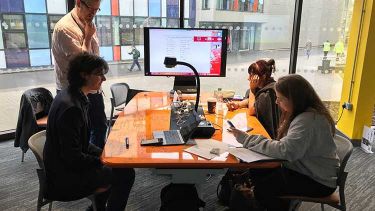
Source:
iStock

Keeping up with the digital demands of edtech can feel like an impossible task, but help is at hand for higher education leaders
With the fourth Industrial Revolution upon us, universities face the challenging task of leading the way on technological change at the same time as preparing future generations for what is to come.
It is unsurprising, then, that institutions – like many workplaces – feel pressured to buy into the ever-expanding world of edtech.
Finding the right balance between embracing new technologies and meeting the needs of staff can be difficult – how can leaders prepare their teams for change in a way that is right for everyone?
It is a question that digital consultants at Jisc – the UK body for digital technology and resources in higher education, further education, skills and research – are asked on a regular basis. And according to cloud solutions consultant Colm Blake, opening up communication is a good place to start.
“A key component of what we do is talking to people face to face,” he says. As a self-proclaimed digital solutions evangelist, it is Blake’s job to determine exactly what it is that institutions need – and, just as importantly, advise them on what they don’t.
Much of the time, universities’ needs come down to “being able to work on data with anybody, on any connection, on any device”, he explains.
As academia becomes increasingly international and interdisciplinary, enabling colleagues to access shared projects easily and securely from wherever they choose has become essential.
To this end, institutions are increasingly turning to cloud-based computing, which Blake endorses. “In its simplest form, it’s a data centre,” he says. Working on cloud-based platforms means that institutions pay only a subscription fee. Programmes are kept online for as long as required, with their maintenance, IT communications and storage delivered by an external provider.
For staff and students, cloud-based computing also means ease of working. They are able to share materials and discuss a project without sending endless emails and attachments. This saves time and creates more room for their ideas and creativity to flourish.
“Working on a cloud-based platform means you still need to look after your data but it frees up that bit of headroom to start thinking innovatively,” says Blake. “The idea is to determine mundane, repetitive tasks which soak up individuals’ time and promote automation where possible.”
Such automation conjures up negative connotations for some, which is why Jisc works with institutions to ensure that the transition towards new technologies is seamless for all involved.
“People are concerned about change…they think you’re migrating their jobs to the cloud,” says Blake. “But that’s not the case – it’s about widening people’s perspectives and being open about the future.”
Chris Thomson, a product specialist at Jisc, also provides direct support for the organisation’s members about how to use technology to support teaching and learning, as well as research. “In the past year, there seems to be quite a few fairly substantial changes to the general landscape, which is quite exciting but also quite challenging for a lot of institutions,” he says.
But while the mood regarding shared online workspaces in particular was once cynical, more universities are now treating them as a tool for innovation. “It’s allowing people to move away from a model of learning [that is] based quite traditionally around information and content to a way of motivating conversation, collaboration and relationships to more of a social model of learning,” Thomson explains.
In his view, it is ultimately the responsibility of managers to lead by example when it comes to embracing digital solutions. Workshops such as Jisc’s Digital Leaders Programme enable participants to share their experiences of digital change and support them in their duties of care.
“Part of the job of a leader is to put themselves in a similar position to colleagues and show what it looks like to experiment, take risks and be creative,” says Thomson. “[They need] to demonstrate that failure is not something that gets punished but is something to learn from and to build on for the digitally rich future.”
To learn more about how the education sector is driving innovation through technology such as the cloud, head to Digifest at the Birmingham ICC from 10-11 March 2020. Entry is free for Jisc member organisations. Get your tickets here.
This article was commissioned by Times Higher Education in partnership with Jisc, the UK body for digital technology and resources in higher education, further education, skills and research.
















